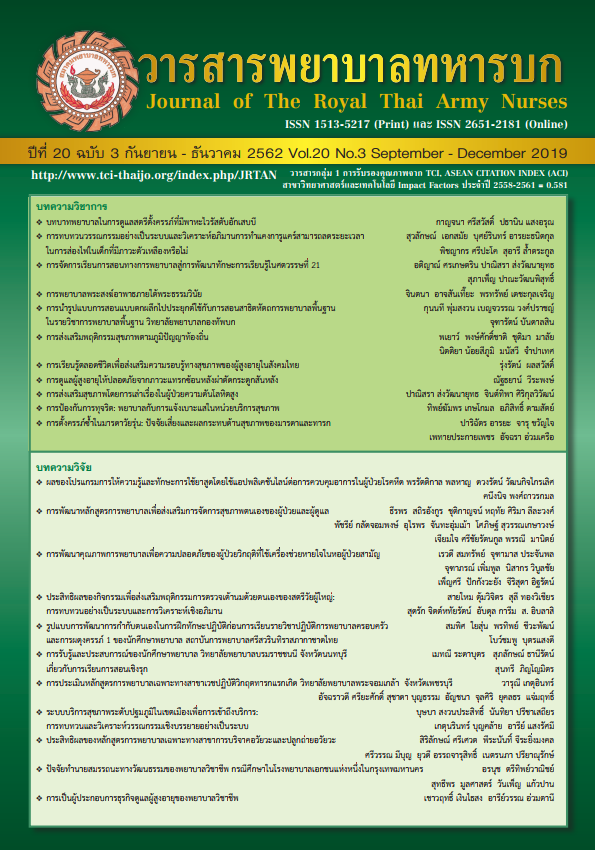Factors Associated with Safety Behavior among Basic Professional Practices of Vocational Students in Thailand
Keywords:
Safety Behavior, Basic Professional Practices, Vocational StudentsAbstract
This study aims to examine safety behavior among basic professional practices of vocational students and factors associated with safety behavior among basic professional practices. The subjects were 420 diploma vocational students affiliated with the office of vocational education commission. The research questionnaire consists of 5 parts: 1) demographic variables 2) safety climate 3) safety knowledge 4) safety motivation and 5) safety behavior. The data were analyzed by descriptive statistics and spearman rank correlation.
The results revealed that safety behavior among basic professional practices of vocational students were at a high level (Mean = 30.05, SD = 4.81). Factors associated with safety behavior among basic professional practices were safety climate (r = .49, p < .05), safety knowledge (r = .37, p < .05) and safety motivation (r = 0.49, p < .05) and factors disassociated with safety behavior among basic professional practices were gender (r = 0.02, p = .56) age (r = -.02, p = .62) years of education (r = -.04, p = .41) practice or classroom lesson in occupational health and safety subjects before basic professional practices (r = .02, p = .55), and past illness/injury experience from basic professional practices. (r = .03, p-value = .52)
Downloads
References
2. Rukkiatwong N. Vocational reform of Thailand. Bangkok: Thailand development research institute; 2016. (in Thai)
3. Narmthongdee R. The vocational training education and potential skills development for Thai workers in ASEAN. Veridian E-Journal, Silpakorn University 2015;8(2):669-681. (in Thai)
4. Jirapongsuwan A. Work environment and health risk: principle and application for occupational health nursing. Bangkok:Danex Intercorperation;2018. (in Thai)
5. Suksomboon S. Factors related to workplace self-protective behavior among woodwork students in the faculty of industrial technology. [Thesis in Public Health Nurse]. Bangkok; Faculty of Graduate Studies Mahidol University;2017. (in Thai)
6. Oner S. Use of personal protective equipment and factors associated with injuries among vocational and technical hight school students. Nobel Medicus 2017;13(2):28-35.
7. Griffin MA, Neal A. Perception of safety at work: A framework for linking safety climate to safety performance, knowledge, and motivation. Journal of occupational health psychology 2000;5(3):347-358
8. Rungsiri C. Factors associated with safety behavior among vocational students in the vocational program at Chitrada vocational schools. Journal of public health nursing 2017;31(2):23-25. (in Thai)
9. Kerdklinhom J. Role of an occupational health nursing. Journal of The Royal Thai Army Nurses 2018;19(3):137-146. (in Thai)
10. Daniel WW. Biostatistics A foundation for analysis in Health Sciences. New York: Wiley & Sons Inc;2005.
11. Hon CK, Chan AP, Yam MC. Relationships between safety climate and safety performance of building repair, maintenance, minor alteration, and addition (RMAA) works. Safety Science 2014;65:10-19.
12. Kines P, Lappalainen J, Mikkelsen KL, Pousette A, Tharaldsen J, Tómasson K, et al. Nordic Safety Climate Questionnaire (NOSACQ-50): a new tool for measuring occupational safety climate. International Journal of Industrial Ergonomics 2011;41:634-646.
13. Sakulthaew C. Factors related to safety behavior in chemistry laboratory among undergraduate studebts. [Thesis in Public Health]. Bangkok;
Faculty of public health Thammasat University;2019. (in Thai)
14. Thongnak T. Relationship between occupational safety and health management and accident of student in colleges under vocational education commission in Angthong. [Thesis in Public Health]. Bangkok; Faculty of public health Thammasat University;2011. (in Thai)
15. Laberge M, Maceachen E, Calvet B. Why are occupational health and safety training approaches not effective? Understanding young worker learning processes using an ergonomic lens. Safety Science 2014;68:250–257.
16. Sutarrom P. Safety awareness effect on safety behavior in work of operation workers of polyfoam group co., Ltd. Valaya Alongkorn review 2018;8(3):114-125. (in Thai)
17. Zohar D. Safety Climate: Conceptualization, Measurement, and Improvement. The Oxford Handbook of Organizational Climate and Culture in Industrial Organization. New York: Oxford university press;2014
18. Lyu S, Hon CK, Albert PC, Chan AP, Francis KW. Wong and Arshad Ali Javed. Relationships among Safety Climate, Safety Behavior, and Safety Outcomes for Ethnic Minority Construction Workers. International journal of Environmental research and public health 2018;15:2-16.
19. Sukkhamjaroon S. The Effects of Safety Climate, Safety Knowledge, Safety Motivation on Safety Behavior in Petroleum Platform Construction Industry. Journal of business, economics and communications 2016;11(2):117-128. (In Thai)
20. Sleet DA, Gielen AC, Diekman S, Ikeda R. Preventing unintentional injury: A review of behavior change theory for primary care. American Journal of lifestyle medicine 2010;4(1):25-31.
21. Christian MS, Bradley JC, Wallace JC, Burke MJ. Workplace safety: A meta-analysis of the roles of person and situation factors. Journal of Applied Psychology 2009;94:1103-1127.
22. Fleming M, Scott N. Beyond hard hats and harnesses, How small construction companies manage safety effectively. In occupational health and safety psychology for small businesses Eds Kelloway E.K. Cooper G 2011.
Downloads
Published
How to Cite
Issue
Section
License
บทความหรือข้อคิดเห็นใดใดที่ปรากฏในวารสารพยาบาลทหารบกเป็นวรรณกรรมของผู้เขียน ซึ่งบรรณาธิการหรือสมาคมพยาบาลทหารบก ไม่จำเป็นต้องเห็นด้วย
บทความที่ได้รับการตีพิมพ์เป็นลิขสิทธิ์ของวารสารพยาบาลทหารบก
The ideas and opinions expressed in the Journal of The Royal Thai Army Nurses are those of the authors and not necessarily those
of the editor or Royal Thai Army Nurses Association.






